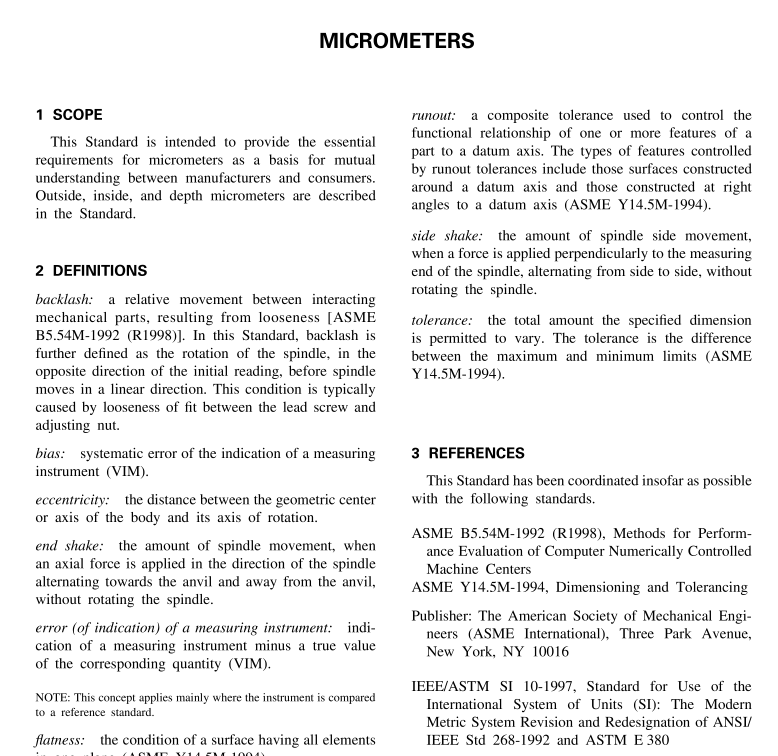ASME B89-1-13 pdf download

ASME B89-1-13 pdf download MICROMETERS
4 MICROMETERS, GENERAL
4.1 Materials The materials used for the component parts of a micrometer shall meet the minimum requirements for hardness, stability, and strength.
4.2 Resolution Micrometers using the inch system shall read to the least count of 0.001 in., 0.0001 in., or 0.00005 in. Micrometers using the metric system shall read to 0.01 mm, 0.002 mm, or 0.001 mm.
4.3 Finish The surface of graduated parts shall have a satin chrome or dull, nonglare finish. All other exposed parts not utilized as measuring components shall be coated to prevent corrosion. Exposed surfaces of measuring components shall have a ground finish with surface roughness not to exceed 32 in. (0.8 ?m) Ra, except where otherwise specified within this document.
4.4 Identification Marking In addition to other markings, instruments shall be marked in a permanent and legible manner with the manufacturer’s name or trademark so that the part number, range of the instrument, and the source of the manufacturer can be readily determined.
4.5 Adjustments Each instrument shall be adjustable to compensate for wear on the measuring faces and/or wear between the screw portion of the spindle and the nut.
4.6 Micrometers Screw Spindle The screw spindle material shall be stabilized, preci- sion-ground, and have a hardness not less than 62 on the Rockwell C Scale. The fit between the spindle and its bearings, including the nut, shall be free-turning without perceptible backlash, end shake, or side shake.
4.7 Measuring Faces All measuring faces shall be hardened to not less than 62 on the Rockwell C Scale.
4.8 Graduations The graduations shall have the depth reduced below the surface of the component carrying the graduations and shall be of contrasting color. Variations in width of the graduated lines on the thimble and fiducial line on the barrel shall not exceed 0.001 in. (0.025 mm).
5 OUTSIDE MICROMETERS (SEE FIG. 1)
5.1 Frame The frame shall be shaped to permit the measurement of a cylinder having a diameter equal to the maximum capacity of the micrometer caliper. The cross section design and the frame material shall be such that when a force of 2 lb for inch-reading micrometers, or 10 N for metric-reading micrometers, is applied to the anvil end of the frame parallel to the spindle axis, the flexure of the frame shall not exceed the tolerances specified in Table 1 or 2.
5.2 Measuring Faces For outside micrometers with flat measuring faces, the maximum flatness error allowable shall not exceed 40 ?in. (1 ?m) for each face. The maximum flatness error allowable for both faces shall not exceed the maximum parallelism error allowable for a given range as stated in Table 1 or 2. Surface finish shall not exceed 4 ?in. (0.1 ?m) Ra.
5.3 Maximum Permissible Error With the micrometer set to read zero at minimum travel, the error of indication, parallelism of the spindle face to the anvil face, and misalignment between anvil and spindle shall not exceed the maximum values indicated in Table 1 or 2 at any point within the measuring range of the instrument.
5.4 Setting Standards The measuring surfaces of setting standards for out- side micrometers shall have a hardness of not less than 60 on the Rockwell C Scale. The deviation in length from the nominal size shall not exceed the values listed in Table 3 or 4.
6 INSIDE MICROMETERS (SEE FIG. 2) Inside micrometers may be either of fixed length or have interchangeable rods that carry the measuring faces. The measuring faces shall have a radius of curvature less than one-half of the smallest measuring range. Surface finish shall not exceed 8 in. (0.2 ?m) Ra.
6.1 Maximum Permissible Error The maximum allowable error in the movement shall be 0.0001 in. within each inch of travel, or 0.0025 mm within each 25 mm of travel. With the screw set at the zero position, the maximum permissible error in overall length of the micrometer head shall be 0.0003 in. (0.0075 mm). When applicable, extensions, collars, or sleeves can be used to extend the range of measure- ment. An additional permissible error of 0.0002 in. (0.005 mm) will be allowed for each extension, collar, or sleeve, in overall length.









